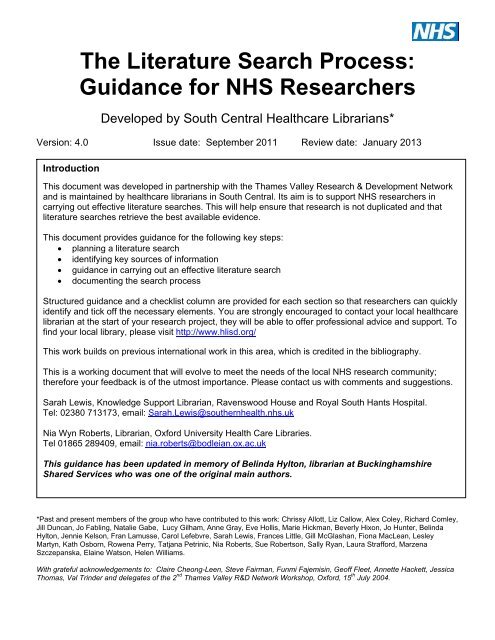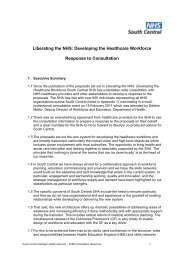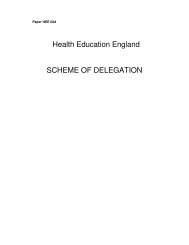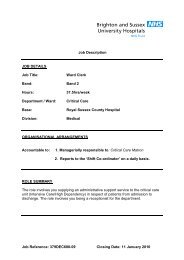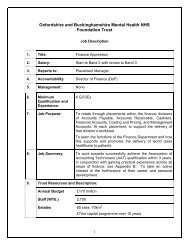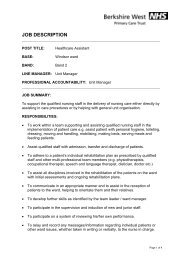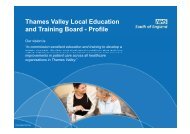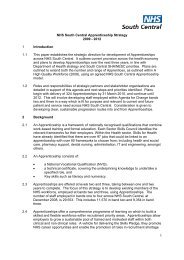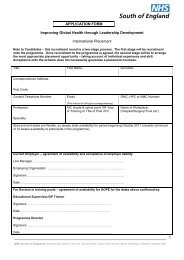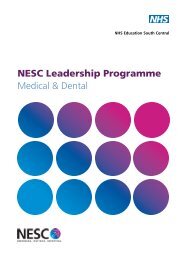Literature Search Protocols - Workforce and Education
Literature Search Protocols - Workforce and Education
Literature Search Protocols - Workforce and Education
You also want an ePaper? Increase the reach of your titles
YUMPU automatically turns print PDFs into web optimized ePapers that Google loves.
The <strong>Literature</strong> <strong>Search</strong> Process:Guidance for NHS ResearchersDeveloped by South Central Healthcare Librarians*Version: 4.0 Issue date: September 2011 Review date: January 2013IntroductionThis document was developed in partnership with the Thames Valley Research & Development Network<strong>and</strong> is maintained by healthcare librarians in South Central. Its aim is to support NHS researchers incarrying out effective literature searches. This will help ensure that research is not duplicated <strong>and</strong> thatliterature searches retrieve the best available evidence.This document provides guidance for the following key steps:• planning a literature search• identifying key sources of information• guidance in carrying out an effective literature search• documenting the search processStructured guidance <strong>and</strong> a checklist column are provided for each section so that researchers can quicklyidentify <strong>and</strong> tick off the necessary elements. You are strongly encouraged to contact your local healthcarelibrarian at the start of your research project, they will be able to offer professional advice <strong>and</strong> support. Tofind your local library, please visit http://www.hlisd.org/This work builds on previous international work in this area, which is credited in the bibliography.This is a working document that will evolve to meet the needs of the local NHS research community;therefore your feedback is of the utmost importance. Please contact us with comments <strong>and</strong> suggestions.Sarah Lewis, Knowledge Support Librarian, Ravenswood House <strong>and</strong> Royal South Hants Hospital.Tel: 02380 713173, email: Sarah.Lewis@southernhealth.nhs.ukNia Wyn Roberts, Librarian, Oxford University Health Care Libraries.Tel 01865 289409, email: nia.roberts@bodleian.ox.ac.ukThis guidance has been updated in memory of Belinda Hylton, librarian at BuckinghamshireShared Services who was one of the original main authors.*Past <strong>and</strong> present members of the group who have contributed to this work: Chrissy Allott, Liz Callow, Alex Coley, Richard Comley,Jill Duncan, Jo Fabling, Natalie Gabe, Lucy Gilham, Anne Gray, Eve Hollis, Marie Hickman, Beverly Hixon, Jo Hunter, BelindaHylton, Jennie Kelson, Fran Lamusse, Carol Lefebvre, Sarah Lewis, Frances Little, Gill McGlashan, Fiona MacLean, LesleyMartyn, Kath Osborn, Rowena Perry, Tatjana Petrinic, Nia Roberts, Sue Robertson, Sally Ryan, Laura Strafford, MarzenaSzczepanska, Elaine Watson, Helen Williams.With grateful acknowledgements to: Claire Cheong-Leen, Steve Fairman, Funmi Fajemisin, Geoff Fleet, Annette Hackett, JessicaThomas, Val Trinder <strong>and</strong> delegates of the 2 nd Thames Valley R&D Network Workshop, Oxford, 15 th July 2004.
South Central <strong>Literature</strong> <strong>Search</strong> <strong>Protocols</strong> v. 4.0, September 2011CONTENTSPage<strong>Search</strong> Planning Form 3Guidance Notes for Use with <strong>Search</strong> Planning Form 4<strong>Literature</strong> <strong>Search</strong> <strong>Protocols</strong>Section 1.Resource checklistLevel 1: Core resources 5a) Minimum core resources 5b) Other core resources 6Level 2: Recommended resources 6Level 3: Additional resources 6Section 2.<strong>Search</strong> strategy checklista) Range of search terms 7b) Database subject headings 7c) <strong>Search</strong> techniques 8Section 3. <strong>Search</strong> documentation checklist 9Section 4. Research notes 10Appendices – see separate document1. Guide to sources of information i2. Additional subject specific databases ii3. Bibliography iii2
<strong>Search</strong> Planning FormSouth Central <strong>Literature</strong> <strong>Search</strong> <strong>Protocols</strong> v. 4.0, September 2011Use this form to identify/clarify the key concepts <strong>and</strong> the scope of your research topic.Date search started: _________________Date search completed: _____________________1. Your Research Topic2. Consider how the following four categories apply to your research topicPatient/Population<strong>and</strong>/or ProblemIntervention/Exposure Comparison/Control(if applicable)OutcomeAlternative Words3. Your Research Question4. <strong>Search</strong> limitsStudy type:Age range:Publication date:Language:Other:3
Guidance notes for use with <strong>Search</strong> Planning FormSouth Central <strong>Literature</strong> <strong>Search</strong> <strong>Protocols</strong> v. 4.0, September 20111. Your Research Topic – briefly describe in your own words the key aspects of your research topic2. Consider how the following four categories apply to your research topic: Patient/population <strong>and</strong>/orproblem, Intervention, Comparison <strong>and</strong> Outcome. These categories form the PICO model (Richardson,1995), an evidence-based model for formulating a clinical question. By dividing your concepts into thesecategories, you will also be doing the groundwork for developing a search strategy. If the PICO model is notappropriate for your topic, you may like to adapt the PICO headings to fit the type of research you areundertaking. Your local healthcare librarian will be able to advise you further.• Patient/Population/Problem - any characteristics that define your patient or population, e.g. targetclinical condition, co-existing condition, ethnicity, age group• Intervention/Exposure - what you want to do with the patient/population/problem e.g. form oftreatment, diagnostic test, education programme, type of service delivery. This can also include anyexposures (e.g. asbestos) or factors influencing prognosis.• Comparison/Control (if applicable) – alternative(s) to main intervention, e.g. placebo• Outcomes - any outcomes or effects relating to the intervention e.g. prevention, side effects,morbidity, quality of life, cost-effectivenessWhen filling in each category, consider any synonyms, alternative keywords, different spellings, acronymsetc. to include in your search strategy - see guidance notes on page 7 for more information.ExampleP I C OANDANDANDacute stroke blood pressure reduction no treatment secondary preventionOR↓OR↓Alternative WordsOR↓OR↓cerebrovascular accidentcerebrovascular eventischaemic strokeanti-hypertensive agentshypertension - drug therapydiuretics, atenolol etclowering blood pressureplacebosecondary prophylaxisreduce mortalityrisk reductionCombining terms - When searching bibliographical databases such as MEDLINE you will need to use OR/AND toput your search together:OR – to combine keywords for similar concepts (i.e. terms in the same column) use OR e.g. blood pressureOR hypertension.AND – to combine keywords for different concepts (i.e. terms in separate columns) use AND, e.g. stroke ANDblood pressure reduction3. Your Research Question – your research topic phrased as a question, incorporating the elementsidentified in the PICO (or similar) model. Example: in people with a prior history of stroke, is blood pressurereduction more effective than no treatment in preventing future stroke events?4. Any <strong>Search</strong> Restrictions – anything related to your topic that you wish to exclude. Generic limits(language, publication date etc) may introduce bias, avoid using these limits if you need a systematicsearch.4
The <strong>Literature</strong> <strong>Search</strong> Process: <strong>Protocols</strong> for ResearchersSouth Central <strong>Literature</strong> <strong>Search</strong> <strong>Protocols</strong> v. 4.0, September 20111) Resource Checklist: Refer to the Guide to sources of information (Appendix 1) for further details about subject coverage <strong>and</strong> access foreach resource listed. Please note: this list is not exhaustive. Additional resources are listed in Appendix 2 but your local healthcare librarian canoffer further advice.Guidance notesThe resource checklist is divided into 3 levels: core,recommended <strong>and</strong> additional. Alongside eachresource, tick the appropriate column: searched, notapplicable (N/A) or unable to access.Level 1 – core resourcesEffective searches across these sources will helpensure that your literature review covers a significantproportion of published research.Consider how retrospective the search needs to be,e.g. from the time when a drug was introduced; alsoconsider whether the coverage of your source issufficiently retrospective <strong>and</strong>/or up-to-date.These resources should be searched as a minimumrequirement unless they are not appropriate to yourresearch topic. If there are time constraints, sectiona) minimum core resources should be given priority.How far you proceed beyond Level 1 will depend on:• The subject of your research• The type of studies you need to locate (e.g. RCTs)• The time available• Availability of sources• How essential it is to ensure your research is notduplicating research elsewhere* Resources marked with a * are not availablethrough NHS Athens or free on the Internet. Accessis through subscription only, but may be accessible atyour local health or academic library.See next page for continued guidance notes.LEVEL 1: CORE RESOURCESa) Minimum core resources:• Cochrane Library• Centre for Reviews <strong>and</strong> Dissemination (CRD) for latest updates• MEDLINE OR PubMed• EMBASE• Key health <strong>and</strong> social care databases as appropriateo AMED (Allied Medicine)o BNI (Nursing)o Campbell Library of Systematic Reviewso CINAHL (Nursing <strong>and</strong> Allied Health)o HMIC / Kings Fund Library (Health Management)o Maternity <strong>and</strong> Child Care*o NHS Networks Commissioning Zoneo OTseeker (Occupational Therapy)o PeDRO (Physiotherapy)o PsycINFOo Social Care Onlineb) Other core resources:• BioMed Central• Evidence summaries e.g. Clinical Evidence *, Prodigy• Evidence-based gateways e.g. NHS Evidence, TRIP• Guidelines sites e.g. NHS Evidence, NICE• Websites of relevant associations / bodies<strong>Search</strong>ed N/A Unable toaccess5
South Central <strong>Literature</strong> <strong>Search</strong> <strong>Protocols</strong> v. 4.0, September 20111) Resource Checklist (continued)Level 2: Recommended resourcesSome of these resources may help to locateunpublished literature including theses & conferenceproceedings.They are useful if you need a greater level ofconfidence that you are not duplicating otherresearch. However, access to some of these sourcesmay be limited.Appendix 2 lists more specific subject databaseswhich are not included here.* Resources marked with a * are not availablethrough NHS Athens or free on the Internet. Accessis through subscription only, but may be accessible atyour local health or academic library.LEVEL 2: RECOMMENDED RESOURCESConference proceedings• ZeTOCDissertations <strong>and</strong> Theses• DART Europe E-Thesis Portal• Dissertation <strong>and</strong> Theses Database *• EThOS• Index to Theses*• Networked Digital Library of Theses <strong>and</strong> DissertationsDrug Information• Drug <strong>and</strong> Therapeutics Bulletin *• Micromedex *• National electronic Library for Medicines• Pharmaceutical <strong>and</strong> device manufacturersGrey <strong>Literature</strong>• Open GreyLibrary cataloguesOther resources• QIPP (Quality, Innovation, Productivity <strong>and</strong> Prevention)• UK Duets (Database of Uncertainties about the Effects ofTreatments)Subject Specific Databases - see Appendix 2 for more options• ASSIA (Applied Social Sciences Index <strong>and</strong> Abstracts)*• BIOSIS Citation Index* / Biosis Previews * (Life Sciences)• Biological Abstracts*• ChildData*• ERIC (<strong>Education</strong> Resources Information Center)• Global Health *• Health Business Elite• SciVerse Scopus*6<strong>Search</strong>ed N/A Unableto access
South Central <strong>Literature</strong> <strong>Search</strong> <strong>Protocols</strong> v. 4.0, September 2011Level 3: Additional resourcesThese resources will further increase thecomprehensiveness of your search. N.B. you maywant to weigh up the likelihood of locatingsignificantly new information before investing the timeneeded to explore these methods.RECOMMENDED RESOURCES CONTINUED• Science Citation Index *• Social Sciences Citation Index *• Toxnet (Toxicology)• World Health Organisation Regional DatabasesUnpublished Studies including Clinical Trials• ClinicalTrials.gov• metaRegister of Controlled Trials (mRCT)• NIHR Clinical Research Network Portfolio DatabaseWeb search engines e.g. GoogleLEVEL 3 : ADDITIONAL SEARCH METHODS• Contacting centres of excellence <strong>and</strong> experts in the field• Email / online discussion groups• H<strong>and</strong> searching of key journals• Citation tracking / reference list checking<strong>Search</strong>ed N/A Unableto access7
South Central <strong>Literature</strong> <strong>Search</strong> <strong>Protocols</strong> v. 4.0, September 20112) <strong>Search</strong> Strategy ChecklistBefore carrying out your search you will need to identify your research question <strong>and</strong> plan your search strategy. You will already have identified yourresearch question <strong>and</strong> broken it down into different concepts when completing the <strong>Search</strong> Planning Form.This section will help you identify a range of keywords relevant to your research question. It includes essential search techniques that should beused, wherever possible, to carry out an effective search of your chosen sources. Contact your local healthcare librarian for further advice / trainingGuidance notesOften, initial searches will highlight otherappropriate text words (words or phrases thatmight appear in the text of an article) <strong>and</strong>database subject headings.Therefore, it is useful to carry out a pilot searchin each database <strong>and</strong> review your search terms(<strong>and</strong> if necessary, your research question <strong>and</strong>its scope) before carrying out your finalsearches.a) Range of search termsIdentify a range of search terms for each of your identified search concepts, considering:• Synonyms, e.g. aged; elderly• Acronyms, e.g. AIDS, CHD etc.• Differences in terminology across national boundaries, e.g. Accident <strong>and</strong>Emergency / Emergency Room• Differences in spellings, e.g. anaemia / anemia• Old <strong>and</strong> new terminology, e.g. mongolism / down syndrome• Br<strong>and</strong> <strong>and</strong> generic names, e.g. coumadin / warfarin• Lay <strong>and</strong> medical terminology e.g. stroke / cerebrovascular accidentUsed / IdentifiedSubject headings are used to index the contentof most bibliographic databases (MEDLINE,EMBASE etc.) Example: heart attack is indexedunder MYOCARDIAL INFARCTIONThe subject headings list used in MEDLINE iscalled MeSH (Medical Subject Headings).Look for the MeSH or Thesaurus options toidentify the most appropriate subject heading forthe keyword you have entered.Correct use of subject headings improves theaccuracy of your results <strong>and</strong> is essential to aneffective search. See section 2c).b) Database subject headings• Identify appropriate subject headings for each database used• Check coverage, scope <strong>and</strong> definition of each subject headingNB: Sometimes subject headings are not defined as you might expect, e.g. the MeSHheading “SURGERY” is used to index material on the discipline of surgery, notsurgical procedures (this is indexed under SURGICAL PROCEDURES, OPERATIVE).See next page for continued guidance notes.8
South Central <strong>Literature</strong> <strong>Search</strong> <strong>Protocols</strong> v. 4.0, September 20112) <strong>Search</strong> Strategy Checklist(continued)Guidance Notesc) <strong>Search</strong> techniques• Carry out separate searches for each individual concept <strong>and</strong> thencombine at a later stageUsed /IdentifiedN/AMost of these search techniques are for usewith bibliographic databases, e.g.MEDLINE. If a particular search techniqueis not applicable, tick the box in the N/Acolumn.Truncation symbols vary depending on theservice provider. The most common is *which is used in many databases such asCINAHL <strong>and</strong> Medline. Other databases mayuse $ or ? to represent different numbers ofcharacters so you need to check the helpfiles.Combining search resultsUse AND to combine two differentconcepts, e.g. diabetes AND insulinExample search1. diabetic OR diabetes2. retina OR eye3. 1 AND 2• Use a combination of text words (free text) <strong>and</strong> subject heading searches• Use appropriate truncation for text word searches where applicable, e.g.nurs* to find nurse, nurses, nursing etc.• ‘Explode’ (i.e. exp<strong>and</strong>) database subject headings where appropriate toinclude narrower terms• Avoid restricting database subject heading searches using the ‘majordescriptors’ or ‘subheading’ options in the first instance (to avoid missingrelevant material)• Use AND / OR appropriately to combine results of separate searches(AND will narrow your search – yourresults must include ALL your statedconcepts)Use OR to search for similar concepts, e.g.retina OR eye(OR will widen your search - your results willinclude a MINIMUM OF ONE of your namedconcepts)• Avoid limiting your search to English language (to help prevent bias)• When searching websites or other electronic sources, use the ‘Advanced’search option where available• If appropriate, use search filters (pre-prepared search strategies) toidentify particular types of research studies e.g. r<strong>and</strong>omised controlledtrials. Try PubMed’s Clinical Queries, see the Cochrane Library H<strong>and</strong>bookor contact your local healthcare librarian for advice.Updating searches: this process can havemany pitfalls. If you have a pre-preparedsearch that you wish to update or re-run ata later date, please contact your localhealthcare librarian.• Use the PubMed ‘related articles’ function <strong>and</strong> lists of references inCINAHL• Check the references cited in any research / other relevant materialretrieved9
3) <strong>Search</strong> Documentation ChecklistSouth Central <strong>Literature</strong> <strong>Search</strong> <strong>Protocols</strong> v. 4.0, September 2011Guidance NotesThis checklist outlines the minimum requiredto document the search process carried out insupport of any research proposal.All elements must be clearly documented foreach resource searched.See the Guide to Sources of Information inthe Appendices for details of each resourcelisted in the checklist.Please ensure your research proposal includes:a) Clearly stated research questionb) Explanation of the scope of the research questionc) For database searches, specification of the following:• Title of database searched (e.g. MEDLINE)• Name of the database provider (e.g. NHS Evidence)• Date search conducted• Complete search strategy used.Attach print outs of search strategies for each database used• Dates covered by the search (e.g. 1990-present)d) For specific websites (other than online databases above), specification of thefollowing:• Name of the resource, (e.g. metaRegister of Controlled Trials)• Publisher of the resource (e.g. US National Library of Medicine)• Web address (URL)• <strong>Search</strong> terms used• Date accessede) For search engine searches, specification of the following:• <strong>Search</strong> engines used (when searching across the Internet, e.g. Google, or searchingwithin a website, e.g. NHS Evidence)• Web address• <strong>Search</strong> terms used• Date searchedIncluded10
Research Notes11


